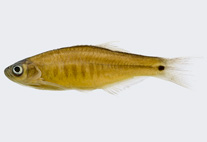Abstract
Danio feegradei Hora is redescribed based on recently collected specimens from small coastal streams on the western slope of the Rakhine Yoma, ranging from the Thade River drainage southward to slightly north of Kyeintali. Danio absconditus, new species, is described from the Kyeintali Chaung and small coastal streams near Gwa, south of the range of D. feegradei. Both species are distinguished from other Danio by the presence of a dark, elongate or round spot at the base of the caudal fin and a cleithral marking composed of a small black spot margined by a much smaller orange spot. Danio feegradei is characterized by the colour pattern, with series of white spots along the otherwise dark side; D. absconditus by about 7-–11 dark vertical bars on the abdominal side. Within Danio, the presence of a complete lateral line, cleithral spot, and 14 circumpeduncular scales is shared with D. dangila and similar species, but these character states may be plesiomorphic as suggested by the shared presence of cleithral spot and complete lateral line in Devario and Betadevario. In other Danio the cleithral spot is absent, the lateral line is short or absent, and the circumpeduncular scale count is lower (10–12). Twenty teleost species are reported from streams on the western slope of the Rakhine Yoma, all probably endemic. The parapatric distribution of D. absconditus and D. feegradei is unique within the genus, and may be partly explained by changes in eustatic sea levels.

